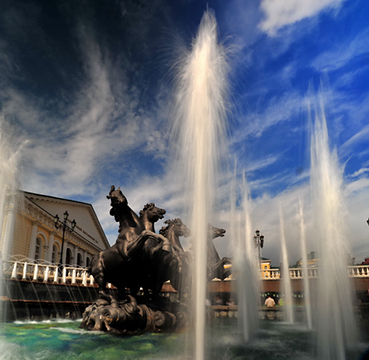Von Denis und “ProPhoto”
Neutral filters may be called dimming filters or ND filter (Neutral Density). If you are long shutter speed photographer, you can use neutral filter not only at night, but also during the day time.
Dimming filter does what exactly the name means – dimming, in other words reducing the volume of light, that comes through the lens. This filter may be useful when:
» you want to make a portrait with open diaphragm to reduce depth of field during the sunny day.
» you want to make a portrait with flash but your camera does not have FP-synchronization and shutter speed is restricted by camera.
» you want to make effect of blurring motion (like waterfall) but it is too bright to make shutter speed longer.
» you want to erase walking people and moving objects to shot only buildings during the day time.
We can see only one couple of young people who are seating on the bench and a tourist with a map. If we make shutter speed longer there will be no people left on the picture.
Due to the quick change of the weather conditions color and lighting is different. Neutral filters may be of different density that can be figure out from the name of the filter. The most light one is ND2. Number means the proportion of light that comes through the filter (for ND2 the proportion is 1/2, that is a half of the whole light volume). The next towards the dark is ND4 and ND8. If you attached several ND filters an once and want to figure out what did you get in total, you have to multiply all numbers of the filters attached. ND2xND4=ND8.
But if you want to set a one or more seconds shutter speed during sunny daytime, you will need ND1000 or more. Besides you have to use tripod. By the way, I do not see any reason to buy ND2, because ND2 effect can be achieved by general C-PL filter. Concerning C-PL filters beside ND filters there is a special category that is variable ND filters. Variable ND filter consists of two C-PL filters that are sandwiched together. Linear sides of two filters turned inside to face each other. This kind of construction requires high quality standards.
But if you want to set a one or more seconds shutter speed during sunny daytime, you will need ND1000 or more. Besides you have to use tripod. By the way, I do not see any reason to buy ND2, because ND2 effect can be achieved by general C-PL filter. Concerning C-PL filters beside ND filters there is a special category that is variable ND filters. Variable ND filter consists of two C-PL filters that are sandwiched together. Linear sides of two filters turned inside to face each other. This kind of construction requires high quality standards.
There is no particularly noticeable difference between linear PL or circular PL filters if you use them separately. But if there are two filters one attached to the other, it is a different story. Irregularity of the light polarizing process when coming from one filter to another will cause dark zones on the image. So if you decided to buy one of the variable ND filter be aware of cheap made in China products. The result will disappoint you. One good option for professionals would be Kenko NDX.
This filter allows to change neutral density from 2 to 1000 and besides that dark zones moire appears only at the maximum position. Usual usage guarantees stable light reducing without color shift. Prepare you wallet because it is expensive equipment.
Coming close to maximum zone dark areas appear. This time we got lucky, only two corners came dark as if gradient filter is used.
Kenko NDX filter is good except the package. It is well done, but inconvenient and fragile. The package must be square and of soft plastic.
With ND filter of high neutral density like Kenko NDX one may shot small nuclear blast or black spots on the Sun.
For that purpose you might need tele lens with focal length 300mm or more. I shot the Sun with 28-300mm and thought it is better to use high resolution camera like Nikon D800. Do not forget to clean CCD sensor, because black spots on the Sun will be dust on your CCD sensor.
There is one more tip for you. Shooting with ND filter using tripod exposure measuring process may go wrong because of light leaking through the open viewfinder. I suggest you to close viewfinder window by cap or finger. Some cameras have a lever that shuts down viewfinder.
 ND filters must be used upon specific purpose. ND filter does not make your images better. It makes them different. And filter is just a tool to achieve your creative intentions.This is photo sample with ND filter.
ND filters must be used upon specific purpose. ND filter does not make your images better. It makes them different. And filter is just a tool to achieve your creative intentions.This is photo sample with ND filter.
Here is example where filter is not desirable.
Original quality examples made with Kenko NDX filter are here:












